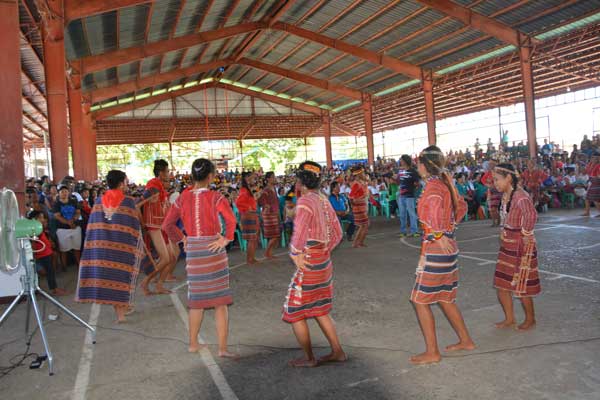The First Anniversary and Town Fiesta was held on May 11, 1956 during the administration of Municipal District Mayor Alfonso Lista.
 First Anniversary celebration of the municipality in 1956. Sitting in front: Miss Anita Lista (now Mrs. Bernardino) Mayor Alfonso Lista, Miss Miguela Concepcion (now Mrs. Santiago).Flanking them are the members of the orchestra.
First Anniversary celebration of the municipality in 1956. Sitting in front: Miss Anita Lista (now Mrs. Bernardino) Mayor Alfonso Lista, Miss Miguela Concepcion (now Mrs. Santiago).Flanking them are the members of the orchestra.
The founding anniversary was celebrated in the next years with the succession of leaders who served the following terms:
- Hon. Jose G. Bayawon - 1959–1969; Hon. Carlos Cattiling -1969-1971;
- Hon. Gabriel T. Chocyagan -1972-1979;
- Hon Gaudencio Manuel—April 1979-December 1979;
- Hon. Aloysius D. Lumauig -1980– 1986;
- Hon John C. Langbayan Sr. –1986-1988;
- Hon. Pio N. Himoldang -OIC 1987-1988;
- Hon. Benedict D. Lumauig –1988-1992;
- Hon. Aloysius D. Lumauig -1992-1995;
- Hon. Glenn D. Prudenciano 1995-2004;
- Hon Charles L. Cattiling -2004-2010 ;
- Hon. Glenn D. Prudenciano -2010-2019;
- Hon. Edralin B. Alipio –2019 to present.
In 1996, then Mayor Glenn D. Prudenciano coined “Ammung Festival” to give a distinct name for the celebration. “Ammung” is a Ga’ddang term for ‘meeting’ or ‘gathering together.’ The Ga’ddangs are the first settlers on the northern part of the municipality. They had established communities before Potia became a Municipality in the old Mountain Province in May 11, 1955.
Today, “Ammung Festival” is ever flourishing as tribes and communities are closely involved in the celebration. The festival is a ‘must see’ and ‘must experience’ because of its fun-filled, gleeful, interesting and colorful events and activities.

The word “AMMUNG” means ‘meeting’ or ‘gathering’. It is filled with the different colors that symbolize happiness, enjoyment and a lot of fun.
The sun at the upper left of the logo symbolizes the progress and the development of the municipality.
The banderitas and the word FESTIVAL symbolize the merriness and the joviality of the town because of the good harvest the whole year round. The carabao stands for the patience and hard work of the people of the town.
The bamboo that bordered the other images signifies the versatile attitude of the people of the town that they can bend along with the ‘waves’ and changes and adapt to local circumstances for survival or for life.
At the left part inside the bamboo border there is a map of Alfonso Lista and it is surrounded with people holding each other’s hands. This symbolizes unity, peace and integrity of the people of the town.
It also signifies the gathering of the twenty (20) barangays in the town to celebrate.
At the right part inside the bamboo border are the main products of the town. These are the significant treasures of the town because they contribute to the great success of the place. Most of the people of Alfonso Lista live by farming and fishing and they produce these main products.
At the lower part inside the bamboo border are native things like spear, gongs, accessories and others.
These signify that the native cultures of the town are not dying. They are being preserved and continued to be practiced by the people.
At the lowest part of the logo, there are G-strings and at the part where the G-strings meet there is the logo of the town. These indicate that there is peace and harmony among the different tribes in the town.
By
John Spencer Dangilan
Busilac, Alfonso Lista, Ifugao
Winner - AMMUNG LOGO Contest
(Ammung Festival 2015)
 First Anniversary celebration of the municipality in 1956. Sitting in front: Miss Anita Lista (now Mrs. Bernardino) Mayor Alfonso Lista, Miss Miguela Concepcion (now Mrs. Santiago).Flanking them are the members of the orchestra.
First Anniversary celebration of the municipality in 1956. Sitting in front: Miss Anita Lista (now Mrs. Bernardino) Mayor Alfonso Lista, Miss Miguela Concepcion (now Mrs. Santiago).Flanking them are the members of the orchestra.



